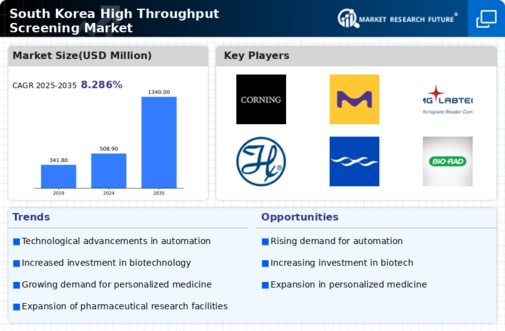Government Support and Funding
Government initiatives in South Korea are playing a crucial role in the expansion of the high throughput-screening market. The South Korean government has been actively promoting biotechnology and pharmaceutical research through various funding programs and grants. In recent years, the government allocated over $200 million to support research and development in this sector. This financial backing not only encourages innovation but also facilitates collaborations between academic institutions and private companies. As a result, the high throughput-screening market is likely to benefit from enhanced research capabilities and the development of novel screening technologies, which could lead to breakthroughs in drug discovery.
Emergence of Biopharmaceuticals
The rise of biopharmaceuticals is a significant driver for the high throughput-screening market in South Korea. As the biopharmaceutical sector continues to expand, there is an increasing demand for efficient screening methods to identify biologically active compounds. The market for biopharmaceuticals is projected to reach $10 billion by 2026, creating a substantial opportunity for high throughput screening technologies. These technologies enable the rapid evaluation of large libraries of biological samples, facilitating the discovery of new therapeutic agents. Thus, the high throughput-screening market is likely to see a robust growth trajectory as it aligns with the needs of the biopharmaceutical sector.
Rising Demand for Drug Discovery
The high throughput-screening market in South Korea is experiencing a surge in demand driven by the increasing need for efficient drug discovery processes. Pharmaceutical companies are under pressure to accelerate the development of new therapeutics, particularly in the fields of oncology and infectious diseases. This urgency is reflected in the market, which is projected to grow at a CAGR of approximately 10% over the next five years. The ability to screen thousands of compounds rapidly allows researchers to identify potential drug candidates more efficiently, thereby reducing time and costs associated with traditional methods. As a result, investments in high throughput technologies are becoming a priority for many organizations, further propelling the growth of the high throughput-screening market.
Increased Focus on Genomic Research
The high throughput-screening market is significantly influenced by the growing emphasis on genomic research in South Korea. With advancements in genomics and personalized medicine, there is a heightened need for high throughput screening technologies that can analyze genetic variations and their implications for drug response. The market is expected to witness a growth rate of around 12% as researchers seek to integrate genomic data into their screening processes. This integration allows for more targeted approaches in drug development, aligning with the broader trend towards personalized medicine. Consequently, the high throughput-screening market is poised to evolve, adapting to the needs of genomic research and enhancing its relevance in the pharmaceutical landscape.
Adoption of Automation in Laboratories
The trend towards automation in laboratories is significantly impacting the high throughput-screening market in South Korea. Automation technologies enhance the efficiency and accuracy of screening processes, allowing laboratories to handle larger volumes of samples with minimal human intervention. This shift is particularly relevant as laboratories strive to increase throughput and reduce operational costs. The market for laboratory automation is expected to grow by approximately 15% in the coming years, indicating a strong alignment with the needs of the high throughput-screening market. As automation becomes more prevalent, it is likely to drive innovation and improve the overall productivity of screening operations.





















Leave a Comment